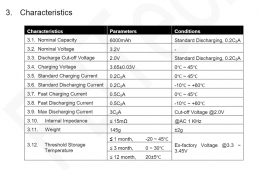Hello Guys
I Really don't know how much solar pannel wattage is required for my LiFePo4 battery with 12.8V,18Ah capacity.
PFA for my battery datasheet
Please guys help me step by step to choose best Solar Panel Wattage for my Battery
I am basically going for off grid solar system for my college project
I am using LiFePo4 battery for energy storage and will be using ready made MPPT Solar Charger Controller
In my area I get sunlight for 8hours and
I will run my system for 9 hours on battery
I am going to use solar panel for charging the battery .
Guys I want to learn and know like how to safely charge my battery without damaging it from Solar Panel using MPPT Solar charge controller
like what's the formula?
Please anybody help me I am newbie to this field
I really appreciate it
Thank you

I Really don't know how much solar pannel wattage is required for my LiFePo4 battery with 12.8V,18Ah capacity.
PFA for my battery datasheet
Please guys help me step by step to choose best Solar Panel Wattage for my Battery
I am basically going for off grid solar system for my college project
I am using LiFePo4 battery for energy storage and will be using ready made MPPT Solar Charger Controller
In my area I get sunlight for 8hours and
I will run my system for 9 hours on battery
I am going to use solar panel for charging the battery .
Guys I want to learn and know like how to safely charge my battery without damaging it from Solar Panel using MPPT Solar charge controller
like what's the formula?
Please anybody help me I am newbie to this field
I really appreciate it
Thank you



